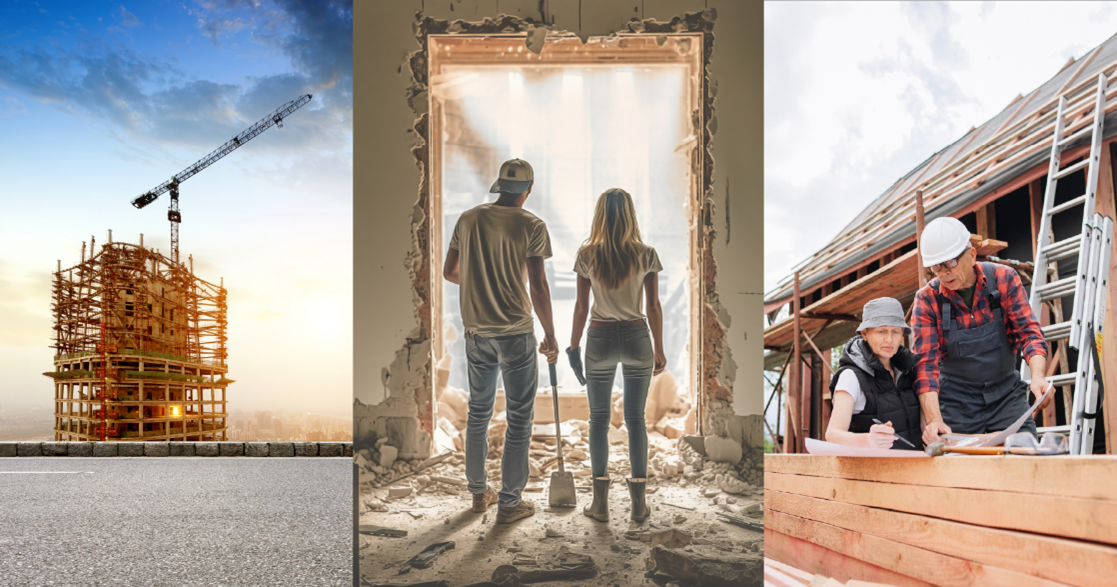When You Want to Live in Your Own Home: Buy a New Build, Renovate, or Build from Scratch?
Property prices in the Czech Republic continue to rise, and during the summer, apartments and houses reached new record highs. Mortgage rates, on the other hand, have stopped declining and stabilized around 4.5%, with a further drop now unlikely. So, if you’re planning to buy your own home with the help of a mortgage, there’s no reason to wait. Have you decided whether to buy a new build, an older property to renovate, or start building right away? Let’s look at what to expect with each option.
If you know you’ll need to finance your housing with a mortgage, it’s best to find out right at the start how much and under what conditions banks will lend you. At this stage, having a financial advisor on your side is invaluable – they can compare offers across the market, negotiate lower rates with banks, and handle the paperwork. They also know exactly which banks to turn to if your situation is specific – for example, if you’re self-employed or run a business.
Once you know how much money you can borrow and under what conditions, you’ll quickly see what type of property you can afford. Now, let’s take a closer look at the pros and cons of several options for acquiring a new home with the help of a mortgage.
Buying a New Build
Purchasing a property as its first owner is usually the most expensive option per square meter – the average price for new builds has exceeded CZK 133,000 per square meter. In Prague, it’s more than CZK 162,000, while in the regions, average prices are over CZK 105,000. VAT is also included in the price of new builds if sold within 23 months of final approval. On the other hand, thanks to higher energy standards and the use of modern materials, you’ll save on utilities and initial maintenance. If you’re buying a property still under construction as part of a development project, you often have the chance to influence layouts or material choices.
If the property is already completed and approved, getting a mortgage (assuming you meet the bank’s requirements) is relatively straightforward, especially if your loan is pre-approved. The bank disburses the funds in a lump sum after receiving all necessary documents and transfers them into escrow (lawyer, notary, real estate, or a bank account), which guarantees a smooth transaction for both seller and buyer.
For development projects still under construction, banks release funds gradually, based on construction phases agreed upon by the bank, buyer, and developer. During construction, you pay only interest on the amount of the mortgage drawn so far. Full repayment of principal and interest begins after final approval and full disbursement of the mortgage. That’s why choosing a reliable developer is crucial to minimize delays.
Pros
-
Modern materials and low energy costs: new homes must meet current energy efficiency standards, typically meaning better insulation, modern heating systems, and lower utility bills.
-
Warranties and low initial maintenance: developers provide guarantees on construction and fittings, avoiding the “unknown past” of older installations.
-
Easier financing when the property already stands: banks usually finance the purchase in a lump sum via escrow, avoiding the complexities of phased disbursement.
Cons
-
Higher price: new builds are more expensive per square meter than older homes, with VAT included in the price.
-
Deadlines and risk of construction delays: unfinished development projects may extend the waiting time, during which you only pay interest.
-
Weaker local infrastructure: new builds located outside established neighborhoods may lack developed amenities.
Buying an Older Property for Renovation
One of the main appeals of older properties is their lower price. For example, older apartments in regional cities can be around 30–40% cheaper than new builds. Of course, it depends on location and condition. Individually, you may secure an even better price if the seller is in a hurry and willing to discount. For renovations aimed at improving energy efficiency, you can also take advantage of subsidies under the “New Green Savings” program, ideal for insulation, heating replacement, solar panels, or other energy-saving upgrades.
Even if you plan to renovate, it’s worth hiring a specialist to assess the property’s technical condition so you know what you’re getting. Since you’re buying a property with a history, always check whether there are easements, liens, or foreclosures. For older, non-insulated properties, expect higher heating costs.
If your renovation is extensive and affects shared parts of an apartment building, you’ll need the homeowners’ association’s (HOA/SVJ) approval. For standalone houses, major structural work will require notifying the building authority or even obtaining a building permit.
Thanks to the lower purchase price, mortgages for older properties are generally more accessible. Within one mortgage, you can finance both the purchase and renovation. In this case, the bank determines the maximum loan amount based on the appraised post-renovation value. To start drawing on renovation funds, you must already own the property. Until the mortgage is fully disbursed, you pay only interest.
The bank will also require a renovation budget, project documentation, and potentially a building permit. During phased disbursement, you must document the progress of work. Banks may also demand completion within an agreed deadline, with extensions incurring fees.
An alternative is to take out a mortgage only for the purchase and later use, for example, a building savings loan for the renovation. This can sometimes offer better terms with longer repayment or lower rates.
Pros
-
Lower purchase price: older properties can be significantly cheaper than new builds.
-
Subsidies: programs like New Green Savings or Fix the House after Grandma support insulation, heating, and renewable upgrades.
-
Established infrastructure: the property is likely in a developed area with amenities.
-
Building savings loan as support: renovations can be financed advantageously through this.
Cons
-
Need to know the true technical and legal condition: hidden defects, liens, or foreclosures may surface.
-
Permits: extensive renovations require bureaucracy and permits.
-
More complex mortgage drawdown: banks may demand budgets, inspections, and proof of progress.
-
Temporary double housing: during major renovations, you may need alternative housing.
Building on Your Own (Self-Build)
The rising cost of construction services has led many to build their own homes in recent years, with help from family, friends, and occasional contractors. Savings can reach tens of percent compared to turnkey houses or development projects. However, building also requires significant time, effort, and navigating mortgage specifics, where a skilled advisor can be invaluable.
Unlike buying a completed property, self-build mortgages are drawn in stages as construction progresses. The land and partially built house serve as collateral, and the bank releases funds gradually after verifying construction progress. Choosing a bank that supports this process without excessive bureaucracy is crucial. A smooth drawdown is far more important than a fractionally lower interest rate.
If you already own land, financing is simpler, and you can draw funds more quickly. If you’re buying land together with building, banks usually require two loans so that the entire mortgage isn’t consumed by land purchase, leaving you paying only interest until construction begins. Ideally, arrange the mortgage for the actual build once you have a project study and are close to a building permit. It’s smart to borrow about 20% more than budgeted – you don’t need to use it, but it creates a cushion for rising material costs or unexpected work.
Banks no longer disburse funds based on invoices but on appraisers’ inspections confirming the construction matches the approved budget. Therefore, keep your budget more general to avoid complications. Mortgages must be fully drawn within two years, with possible (but charged) extensions. Use funds wisely – first for essential structures, later for finishing touches.
For energy-efficient homes, you can receive subsidies exceeding CZK 500,000 under the New Green Savings program. Banks also support green construction with slightly better rates – up to several tenths of a percent lower.
Pros
-
Cost savings: compared to turnkey homes, savings can be significant.
-
Flexibility: build exactly the home you want within your budget.
-
Financial cushion: some banks allow borrowing up to 20% above budget.
-
Subsidies: over CZK 500,000 available for energy-efficient homes.
Cons
-
High time investment: you must dedicate significant time to construction and coordination.
-
Complex mortgage drawdown: staged funding, appraisals, and documentation required.
-
Time limits: the mortgage must be drawn within two years, with extensions incurring fees.
Final Thoughts
Whether you choose a new build, an older property with renovation, or a self-build, each path comes with its advantages and challenges. The common denominator for success is always a smoothly managed mortgage – including bank requirements, staged drawdowns, necessary permits, and deadlines. This is where a financial advisor can save you considerable stress, guiding you through the process from initial calculations to selecting the right bank and ensuring smooth disbursement. They can secure the best terms for you and handle complications, leaving you free to focus on what truly matters – your new home, where you’ll feel at home.



